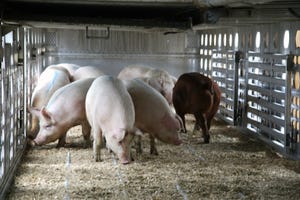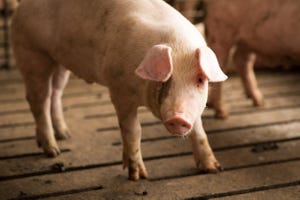Baker recognized for renowned IAV research in swine
ARS scientist's research on the 2009 H1N1 pandemic virus in pigs helped the industry address food-safety concerns in export markets.
April 25, 2024

For pioneering studies on influenza A viruses in swine, Agricultural Research Service scientist Amy L. Baker is the agency's Distinguished Senior Research Scientist of the Year for 2024. Baker, a research veterinary medical officer at the ARS National Animal Disease Center in Ames, Iowa, was one of 12 ARS researchers honored April 23 for their scientific achievements.
“We’re so proud to recognize the outstanding achievements of these 12 scientists. They exemplify the scientific excellence and innovation that our agency seeks in delivering solutions to agricultural challenges nationally and abroad,” said ARS Administrator Simon Liu.
Baker joined the NADC in 2004 and today serves as lead scientist in the center’s Virus and Prion Research Unit in Ames. Among her accomplishments, Baker’s research on the 2009 H1N1 pandemic virus in pigs helped the swine industry address food-safety concerns in export markets. Baker went on to draw national and international acclaim for her sustained research excellence investigating the pathogenesis, diagnostics, vaccinology and interspecies transmission of IAV in swine.
Baker’s systematic genetic and antigenic characterization of IAV revealed previously unrecognized diversity and established a baseline in the United States for monitoring ongoing evolutionary changes in the viruses, as well as the relatedness of U.S. isolates to those found in swine in other parts of the world. This information has also been pivotal to the improvement of commercial swine influenza vaccines.
Baker’s expertise in IAV and interspecies transmission has led to numerous speaking invitations, advisory positions and collaborations, including with USDA’s Animal and Plant Health Inspection Service and the U.S. Centers for Disease Control and Prevention—particularly in response to the ongoing exchange of IAV between people and pigs. Under Baker’s leadership, the NADC’s Virus and Prion Research Unit directly contributes swine IAV genetic and antigenic data to the World Health Organization’s influenza vaccine composition meetings, which are held twice annually to inform decisions on strain selection for future human influenza vaccine production.
ARS also named four 2024 Area Senior Research Scientists of the Year:
Scott M. Geib, with ARS’s Tropical Pest Genetics and Molecular Biology Research Unit in Hilo, Hawaii (Pacific West Area), for his leadership and contributions to the advancement of insect genomics research and national-level initiatives such as the USDA Ag100Pests and Beenome100.
Brian E. Scheffler, with ARS’s Genomics and Bioinformatics Research in Stoneville, Mississippi (Southeast Area), for scientific leadership and innovation ranging from herbicide mode-of-action discoveries to high-quality crop genomes and contributions to SCINet, Ag100Pest and Beeome100.
Curtis P. Van Tassell, with ARS’s Animal Genomics and Improvement Laboratory in Beltsville, Maryland (Northeast Area), for leadership in livestock genomics employing a multi-disciplinary approach to achieve unprecedented advances for the U.S. dairy and beef cattle industries.
Gayle M. Volk, with ARS’s Agricultural Genetic Resources Preservation Research in Fort Collins, Colorado (Plains Area), for leadership on the clonal cryopreservation of critical plant germplasm, collections assessment and training of aspiring plant scientists and genebankers.
ARS is also honored scientists who are in the early phases of their careers. The early-career awards recognize the achievements of ARS researchers with the agency for seven years or less.
This year, the top award in this category, the Herbert L. Rothbart Outstanding Early Career Research Scientist of 2024, goes to Revathi Shanmugasundaram (“Reva Shan”), a research biologist at ARS’s Toxicology and Mycotoxin Research Unit in Athens, Georgia (Southeast Area). Shan is being recognized for her groundbreaking work in evaluating mycotoxin levels in feed, which significantly impacts poultry-related food safety along with poultry health and productivity. Additionally, Shan is recognized for her innovative approach in developing nanoparticle vaccines to neutralize multiple mycotoxins in animal feed.
ARS honored four other Area Early Career Research Scientists:
Mohamed Alburaki, with ARS’s Bee Research Laboratory in Beltsville, Maryland (Northeast Area), for incorporating epidemiological modeling and other scientific innovations to create faster, more accurate diagnoses of bee diseases and other health issues, benefiting beekeepers and regulatory agencies alike.
Matthew S. Crouse, with ARS’s Nutrition, Growth and Physiology Unit in Clay Center, Nebraska (Plains Area), for advancing the understanding of how maternal nutrient restriction during early pregnancy in cattle negatively impacts the embryos and for developing a supplementation program based on targeting the one-carbon metabolism pathway, a key function of all cellular growth.
Brittany E. Davis, with ARS’s Forage-Animal Production Research Unit in Lexington, Kentucky (Midwest Area), for pioneering studies on the nutritional microbiology of grazing ruminants and for research demonstrating the potential of isoflavones naturally found in red clover to help abate symptoms of fescue toxicosis in grazing cattle.
Karen Poh, with ARS’s Animal Disease Research Unit in Pullman, Washington (Pacific West Area), for innovative studies at the intersection of ticks, hosts, pathogens and the environment to implement methods of predicting, preventing and controlling tick infestations and tickborne diseases in livestock.
The agency also announced its 2024 ARS Technology Transfer Award winner. This award recognizes individuals or groups who have done outstanding work in transferring technology to the marketplace.
This year’s winner is the Phosphorous Transport Reduction App Team, consisting of Jim R. Frankenberger and Chad J. Penn—both at ARS’s National Soil Erosion Research Laboratory in West Lafayette, Indiana. Phosphorus that leaves agricultural fields in runoff or drainage water can end up in water bodies like lakes and streams, compromising water quality and causing harm to aquatic life.
The team developed a software application named the P-Trap that makes it easier for users to select, design, build and evaluate phosphorus removal systems that would work best with a specific farm operation. The team’s push to expand awareness and adoption of phosphorus removal systems also extended to furnishing content for a series of training modules and providing consultations and on-site demonstrations, including on how to recycle captured phosphorus from runoff.
Penn also lent his technical expertise to the American Society of Agronomy and the American Society of Agricultural and Biological Engineers, which developed the training modules with support from USDA’s Natural Resources Conservation Service. Together with NRCS, Penn worked to devise a national standard allowing for cost-sharing of the removal systems under the agency’s Environmental Quality Incentives Program.
You May Also Like



